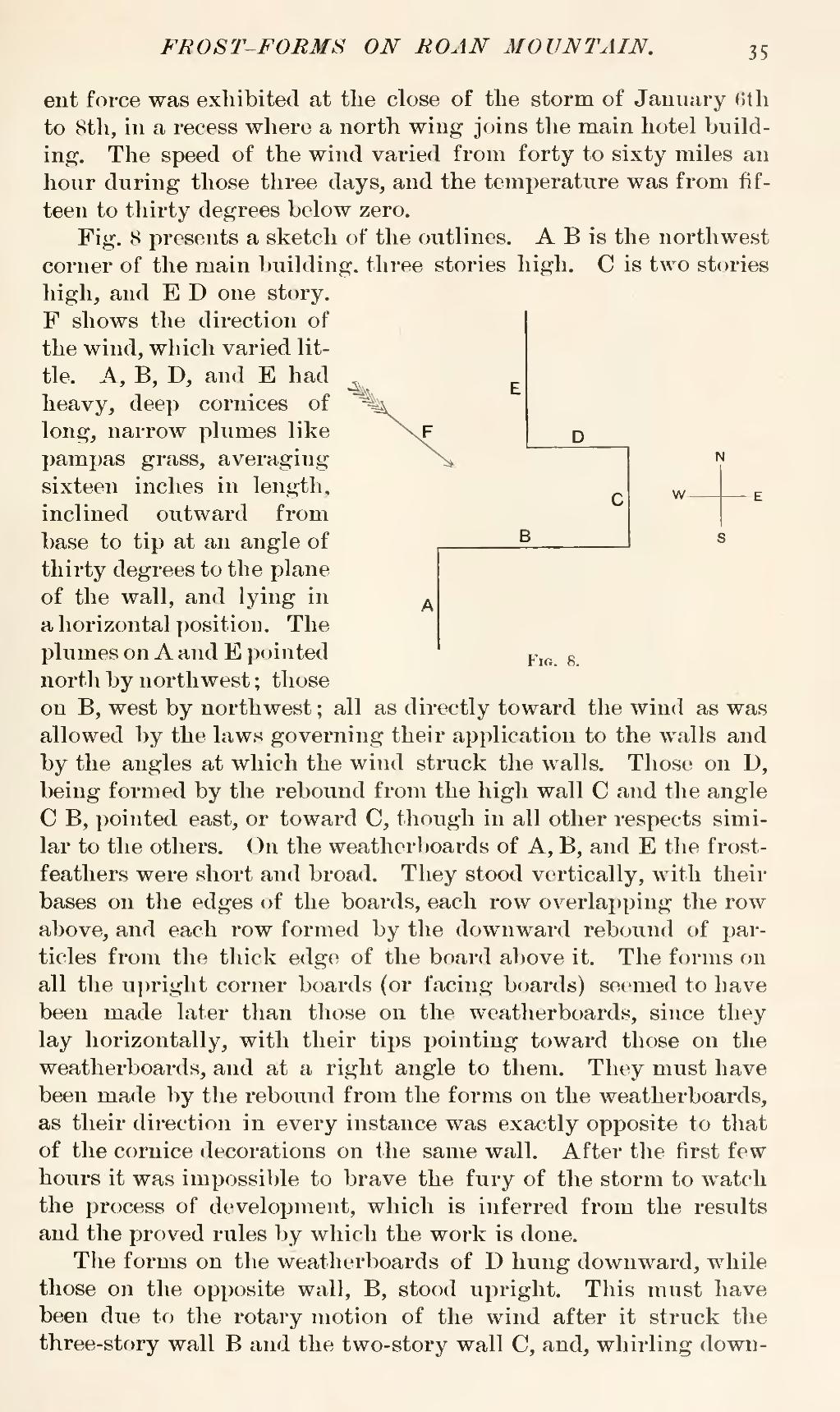ent force was exhibited at the close of the storm of January 6th to 8th, in a recess where a north wing joins the main hotel building. The speed of the wind varied from forty to sixty miles an hour during those three days, and the temperature was from fifteen to thirty degrees below zero.
Fig. 8 presents a sketch of the outlines. A B is the northwest corner of the main building, three stories high. C is two stories  Fig. 8. high, and E D one story. F shows the direction of the wind, which varied little. A, B, D, and E had heavy, deep cornices of long, narrow plumes like pampas grass, averaging sixteen inches in length, inclined outward from base to tip at an angle of thirty degrees to the plane of the wall, and lying in a horizontal position. The plumes on A and E pointed north by northwest; those on B, west by northwest; all as directly toward the wind as was allowed by the laws governing their application to the walls and by the angles at which the wind struck the walls. Those on D, being formed by the rebound from the high wall C and the angle C B, pointed east, or toward C, though in all other respects similar to the others. On the weatherboards of A, B, and E the frost-feathers were short and broad. They stood vertically, with their bases on the edges of the boards, each row overlapping the row above, and each row formed by the downward rebound of particles from the thick edge of the board above it. The forms on all the upright corner boards (or facing boards) seemed to have been made later than those on the weatherboards, since they lay horizontally, with their tips pointing toward those on the weatherboards, and at a right angle to them. They must have been made by the rebound from the forms on the weatherboards, as their direction in every instance was exactly opposite to that of the cornice decorations on the same wall. After the first few hours it was impossible to brave the fury of the storm to watch the process of development, which is inferred from the results and the proved rules by which the work is done.
Fig. 8. high, and E D one story. F shows the direction of the wind, which varied little. A, B, D, and E had heavy, deep cornices of long, narrow plumes like pampas grass, averaging sixteen inches in length, inclined outward from base to tip at an angle of thirty degrees to the plane of the wall, and lying in a horizontal position. The plumes on A and E pointed north by northwest; those on B, west by northwest; all as directly toward the wind as was allowed by the laws governing their application to the walls and by the angles at which the wind struck the walls. Those on D, being formed by the rebound from the high wall C and the angle C B, pointed east, or toward C, though in all other respects similar to the others. On the weatherboards of A, B, and E the frost-feathers were short and broad. They stood vertically, with their bases on the edges of the boards, each row overlapping the row above, and each row formed by the downward rebound of particles from the thick edge of the board above it. The forms on all the upright corner boards (or facing boards) seemed to have been made later than those on the weatherboards, since they lay horizontally, with their tips pointing toward those on the weatherboards, and at a right angle to them. They must have been made by the rebound from the forms on the weatherboards, as their direction in every instance was exactly opposite to that of the cornice decorations on the same wall. After the first few hours it was impossible to brave the fury of the storm to watch the process of development, which is inferred from the results and the proved rules by which the work is done.
The forms on the weatherboards of D hung downward, while those on the opposite wall, B, stood upright. This must have been due to the rotary motion of the wind after it struck the three-story wall B and the two-story wall C, and, whirling down-

